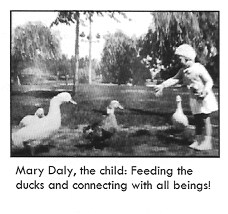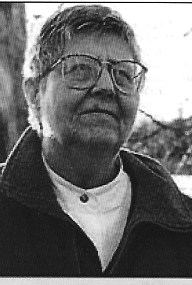This post was written by library volunteer Gail Denisoff.
A fierce “radical feminist” and one of the most influential feminist thinkers of the 20th century who battled Boston College, challenged organized religion, the global oppression of women and patriarchal societies, Mary Daly grew up much more conventionally in Schenectady NY.

Image from Mary Daly's personal collection, published in Waterwheel, Volume 21. Number 1. 2010.
Born on October 16, 1928, Mary was the only child of Frank X. Daly and his wife, Anna C. Morse. Frank, born in 1888, was an ice cream freezer salesman for Daly Brothers Ice Cream on Eastern Avenue while Anna, born in 1890, was a homemaker. Raised in a devout Irish Catholic home on Grosvenor Square, Mary attended local parochial schools including St. John the Evangelist, where she developed an interest in philosophy and theology. At the age of 9 or 10, she was taunted by a boy in her class that he was going to be an altar boy but she could never serve mass because she was only a girl. This encounter sparked a rage that continued throughout her life against the gender caste system, which she later called “patriarchy”, in the Catholic Church as well as all organized religion.
The limits placed on girls were evident throughout her childhood. She recalled an incident when a saleswoman selling children’s books visited her home. One of the books that interested Mary was about ships. When her mother tried to order it, she was dissuaded by the saleswoman who said it was silly to order a book about ships for a girl. This only increased Mary’s interest in ships, especially pirate ships, which she imagined could sail among the stars where there would be no such restrictions. In high school she noticed the “intellectual shortcomings” of boys which she felt obstructed her educational progress because teachers were forced to move more slowly, thus concluding that the concept of male intellectual superiority was only a myth.
Mary’s mother nurtured her interests and educational aspirations. Anna had loved school but was forced to leave during her sophomore year to help out her family. Because of this, she wanted Mary to have the educational opportunities she didn’t have.
Her father was also pulled out of school at a young age. As a child, Mary was always impressed that even though he didn’t go past eighth grade he had written a book, published in 1914, titled “What Every Ice Cream Dealer Should Know.” Seeing a box of these books in her home inspired her desire to be a writer, although she didn’t yet know what she would write about.
Throughout her life, Mary felt she was particularly receptive to visions or messages from nature. She wrote about an incident at the age 14 when she had an extraordinary communication from a clover blossom. She recalled: “It said, with utmost simplicity, ‘I am’. It was an experience I would later call ‘an intuition of Be-ing, the Verb in which we all participate’. Such invitations to my adolescent spirit were somehow intimately connected with the call of books. It was this encounter that launched me on my quest to become a Radical Feminist philosopher.”
 |
| Image from Mary Daly's personal collection, published in Waterwheel, Volume 21. Number 1. 2010. |
Encouraged by her parents, she initially realized her academic goals in a Catholic system of higher education, which she felt limited the rise of women, receiving a BA from the College of St. Rose in 1950, and a MA from Catholic University in Washington, DC in 1952. It was while she was studying for a Masters in English she had a dream that she should study philosophy followed by a vision of herself teaching theology, a subject she had never considered before. Soon after, she saw an ad for The School of Sacred Theology for Women at St. Mary’s College, in Notre Dame, Indiana. It was a new program and when Mary contacted the school about it, she was offered a scholarship and a part time teaching position. She felt challenged at St. Mary’s and after obtaining her Ph.D in Religion in 1954, she hoped to continue her studies in philosophy. Since no universities in the US would allow women in their Ph.D programs for philosophy, she ended up teaching at a small Massachusetts college for five years. Not giving up her aspirations, she was granted a scholarship to the University of Freiburg in Switzerland where she spent seven years and obtained four additional degrees including Ph.Ds in both Philosophy and Theology.
While Mary was in Switzerland, living on a shoestring budget, she managed to travel around Europe a bit. In 1965 she visited Rome for the Second Vatican Council of the Roman Catholic Church. While there, she sat in on sessions where she took note of the contrast between the cardinals and bishops, resplendent in their crimson robes and the few women in attendance as "auditors", nuns sitting docilely in their black habits. She found the contrast appalling and compared the sight of the veiled nuns shuffling to the altar to receive communion from a priest, to a string of lowly ants at a bizarre picnic. This solidified her theory that all of the major religions as well as secular offshoots were just the framework of the concept of patriarchy, created to shield men against unpredictability and disorder – that disorder being the presence of women.
When she returned to the United State in 1966, Mary was ready to “throw my life as far as it would go.” She accepted a position teaching theology at the then all-male Boston College. She proved to be a popular professor with her radical ideas and Irish humor. In 1968 her first book, The Church and the Second Sex, was published in which she exposed the misogynism of the Catholic Church. The book proved to be popular as well as controversial with Mary making several television appearances promoting it. It was not as well received at the Jesuit-run Boston College - her tenure was not granted and she was given a “terminal contract.” Although the college didn’t cite her book as a reason for her firing, the students made the connection and over 1500 demonstrated on her behalf and over 2500 signed a petition protesting her dismissal, resulting in national and international publicity. The college backed down and reluctantly granted her tenure and a promotion. A second book published in 1973, Beyond God the Father: Toward a Philosophy of Women’s Liberation, became one of the most widely read books in the field of feminist studies.

Image from Mary Daly's personal collection, published in Waterwheel, Volume 21. Number 1. 2010.
On November 17, 1971, Mary became the first woman in 336 years to preach at Harvard’s Memorial Church. When she was invited, she felt it was tokenism rather than an honor and thought of declining. She decided to accept “with the intention of giving an anti-sermon that would be a clarion call to all to abandon patriarchal religion” where women and children were marginalized. Urging a mass exodus, hundreds of women as well as some men marched out of the church with Mary.
In 1975, she was denied a full professorship at Boston College on the grounds that she had not produced “substantive work” despite her books and many papers. She was granted a Rockefeller Foundation Humanities grant and took a year off from teaching to write. In the resulting book published in 1978, Gyn/Ecology: The Metaethics of Radical Feminism, Mary shone a light on what she considered injustices and atrocities against women. Boston College administration did not take kindly to the book and made her academic life difficult despite the fact that her presence on campus attracted new students, visiting professors, and prestigious speakers.
During the 1980s Mary continued to write. In 1984 she published Pure Lust: Elemental Feminist Philosophy, a follow-up to Gyn/Ecology, urging women to have the courage to sin. Realizing the need for a new language to express women's realities, she wrote Websters’ First New Intergalactic Wickedary of the English Language, with Jane Caputi in 1987, a dictionary offering strong feminist definitions of words for "Wicked Women." Both were well received.
In 1989, Mary again applied for a promotion to full professor. Despite her publications and influence, she was rejected once more. Fellow faculty and colleagues from around the country, Canada, and Europe sent letters of protest. Students and some faculty protested on her behalf without success. Boston College’s committee wrote, “the Committee recognized the contrast between your works and the more typical demonstrations of scholarly methodology in publications by which candidates for promotion to Professor are judged.”
Undaunted, Mary continued her career at Boston College, writing and accepting speaking engagements around the world. In 1992 she published Outercourse: the Bedazzling Voyage, a philosophical autobiography. Quintessence: Realizing the Archaic Future - a Radical Elemental Feminist Manifesto followed in 1998.
In 1999 she refused to allow two male students to enroll in her feminist ethics class. Although she had taught men until the college became coed, she began to teach women-only classes after that, stating the presence of men often intimidated women and prevented them from speaking freely. She taught feminism classes to men separately for years and offered to do so for these two students. Instead they chose to sue Boston College with backing from the Center for Individual Rights, a conservative advocacy group. Boston College revoked her tenure and announced that she had agreed to retire. Mary sued them for violation of tenure. In 2001 they settled out of court, the college still maintaining she retired, Mary stating she “was disappeared."

Image from Mary Daly's personal collection, published in Waterwheel, Volume 21. Number 1. 2010.
After leaving Boston College, Mary continued lecturing, mentoring graduate students, and writing. Her last book, Amazon Grace: Recalling the Courage to Sin Big was published in 2006. In her late 70s, Mary's health began to fail. She was faithfully cared for at home by a group of her former students and friends, calling themselves Team Mary, until she became too ill and entered a nursing home. Mary died at the age of 81 on January 3, 2010, and her ashes were buried at Mount Auburn Cemetery in Cambridge, MA. She bequeathed her papers to Smith College which are available to researchers.
Although her methods were far from conventional, Mary was one of the foremost feminist thinkers of the 20th century. Often referring to herself as a "positively revolting hag," Mary Daly had the courage to speak boldly and “sin big.” She continues to be an important influence in the field of feminist theology and philosophy.

Image from Mary Daly's personal collection, published in Waterwheel, Volume 21. Number 1. 2010.
References:
Bindel, Julie. "Mary Daly Obituary." The Guardian. January 27, 2010.
Daly, Mary. "Sin Big." The New Yorker. February 26 and March 4, 1996.
Fox, Margalit. "Mary Daly, a Leader in Feminist Theology, Dies at 81." New York Times. January 6, 2010.
Hunt, Mary. "Mary Daly - 1928 to 2010 - A Biographical Sketch." Waterwheel. Volume 21. Number 1. 2010.
Mary Daly. Philosophy Now. Issue 33.
United States Federal Census. 1930, 1940.
